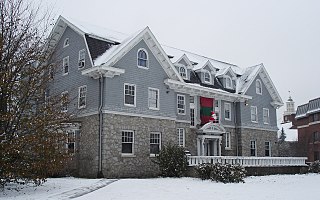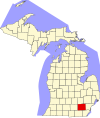
North American fraternity and sorority housing refers largely to the houses or housing areas in which fraternity and sorority members live and work together. In addition to serving as housing, fraternity and sorority housing may also serve to host social gatherings, meetings, and functions that benefit the community.

Deke House, the Delta Kappa Epsilon or "Deke" House on the campus of Cornell University, was built in 1893 and was listed on the National Register of Historic Places in 1991. It was designed by William Henry Miller to serve as a fraternity house. Two trees which Theodore Roosevelt planted in front of the house are on the National Register of Historic Trees.

The Phi Delta Theta House located at 1437 Washtenaw Ave., Ann Arbor, Michigan, is a splendid example of Georgian Revival architecture. The house, finished in 1903, is on the Michigan Register of Historic Places. It is located near the southeast edge of the University of Michigan's Central Campus.

The Phi Gamma Delta Fraternity House in Minneapolis, Minnesota is the University of Minnesota chapter house of Phi Gamma Delta. The house, located just across University Avenue from the East Bank Campus, is listed on the National Register of Historic Places for its distinctive architecture, as well as its role in the development of fraternity housing in Minnesota.
Delta Upsilon Fraternity House may refer to:

The Delta Psi, Alpha Chapter fraternity house is located at 434 Riverside Drive in the Morningside Heights neighborhood of Manhattan, New York City. It was purpose built in 1898 and continues to serve the Columbia chapter of the Fraternity of Delta Psi, a social and literary fraternity.

St. Anthony Hall House is a historic fraternity house located in the University City neighborhood of Philadelphia, Pennsylvania. It is the Delta chapter house for the social and literary Fraternity of Delta Psi for the University of Pennsylvania. It was added to the National Register of Historic Places in 2005.

The Judge Robert S. Wilson House, also known as the Wilson-Wahr House, is a private house located at 126 North Division Street in Ann Arbor, Michigan. It was listed on the National Register of Historic Places in 1972.

The Tivadar and Dorothy Balogh House is a private house located at 49800 Joy Road in Plymouth Township, Michigan. It was listed on the National Register of Historic Places in 2013.

Phi Gamma Delta House is an historic fraternity house at 79 College Avenue, near the campus of the University of Maine in Orono. It is the only Tudor Revival fraternity house on that campus, and was built to provide increased housing to the school's male student population. The architects were Crowell & Lancaster. It was listed on the National Register of Historic Places in 2013.

The Saint Anthony HallTrinity College chapter house is an historic fraternity building located at 340 Summit Street in Hartford, Connecticut. Built between 1877 and 1878, it is a significant early work of the American architect J. Cleaveland Cady. The building was listed on the National Register of Historic Places in November 1985.

Delta Upsilon Chapter House is a historic building located in Ames, Iowa, United States. It is considered one of the more imposing architectural examples among fraternity chapter houses at Iowa State University.

The North Ann Arbor Street Historic District is a residential historic district, consisting of the houses at 301, 303, and 305-327 North Ann Arbor Street in Saline, Michigan. It was listed on the National Register of Historic Places in 1985.

The Langdon Street Historic District is a historic neighborhood east of the UW campus in Madison, Wisconsin - home to some of Madison's most prominent residents like John B. Winslow, Chief Justice of the state Supreme Court, and nationally recognized historian Frederick Jackson Turner. The district has a high concentration of period revival style buildings - many built from 1900 to 1930 to house Greek letter societies, and many designed by Madison's prominent architects. In 1986 the district was added to the National Register of Historic Places.

Nickels Arcade is a commercial building located at 326-330 South State Street in Ann Arbor, Michigan. It was listed on the National Register of Historic Places in 1987. The building is notable as perhaps the only remaining example in Michigan of a free-standing commercial arcade building of a type that was popularized by the Cleveland Arcade.

The Thomas Earl House was built as a single-family home located at 415 North Main Street in Ann Arbor, Michigan. It was listed on the National Register of Historic Places in 1992. The house has been renovated to office space.

The Floyd R. Mechem House is a single-family home located at 1402 Hill Street in Ann Arbor, Michigan. It was listed on the National Register of Historic Places in 1999.

The Arnold and Gertrude Goss House is a single-family home located at 3215 W. Dobson Place in Ann Arbor, Michigan. It was listed on the National Register of Historic Places in 2008.

The Xi Chapter, Psi Upsilon Fraternity is a fraternity chapter at Wesleyan University in Middletown, Connecticut. Its 1891 building, the Psi Upsilon Fraternity Building, is an architecturally significant example of Romanesque and Jacobethan architecture, and was listed on the National Register of Historic Places in 2009.

Alpha House is a fraternity house located at 293 Eliot Street in Detroit, Michigan. It is significant as the longtime headquarters of the Gamma Lambda Chapter of Alpha Phi Alpha fraternity. The house was listed on the National Register of Historic Places on August 26, 2021.
























